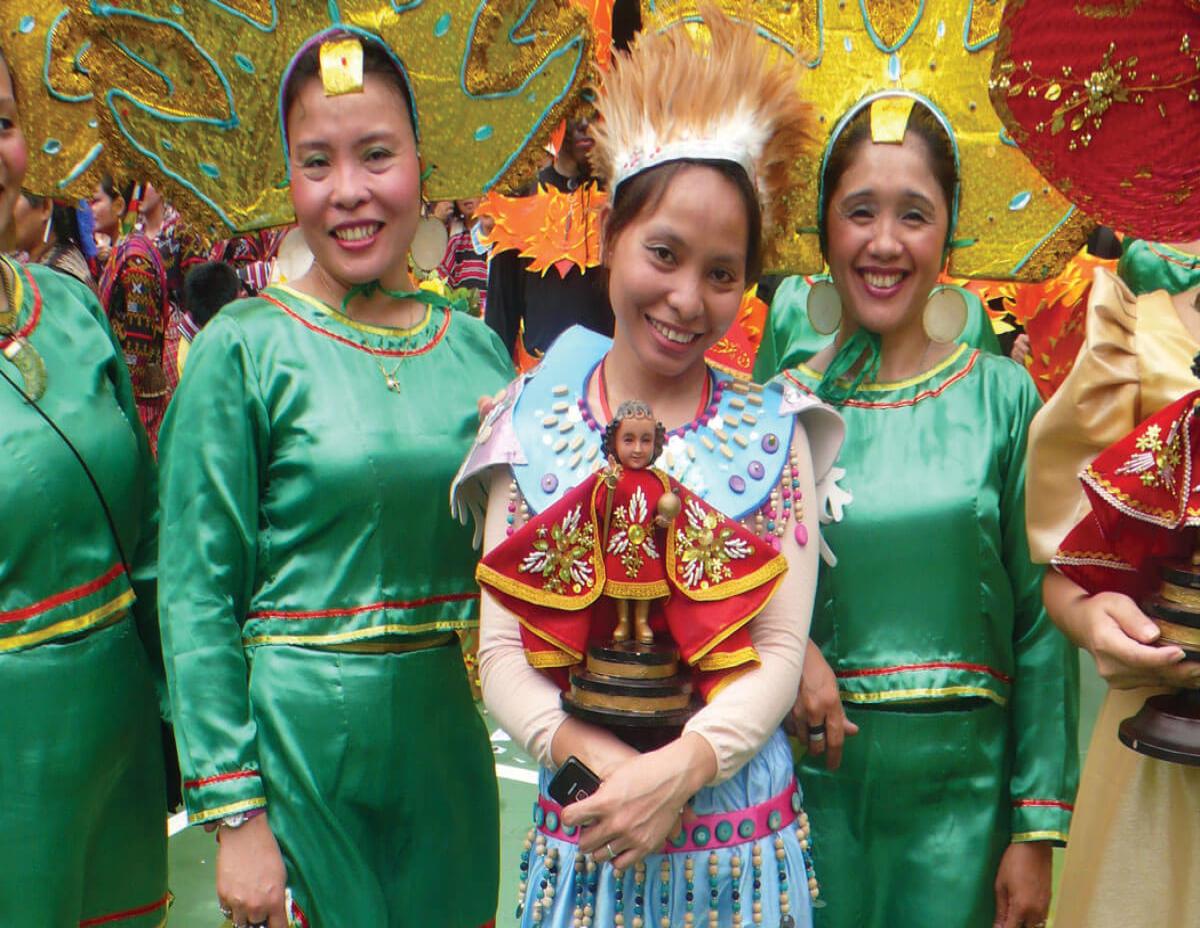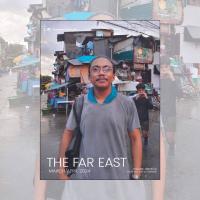
Displaying a replica of the Santo Niño in preparation for dancing the part of Queen Juana at the festival. Photos: Fr Jim Mulroney SSC
A carving out of wood with little artistic merit, yet adorned in robes of kingly magnificence, the Santo Niño is a source of religious myth and fable dating back to the sowing of the first seeds of Christianity in Philippine soil just half a millennium ago.
Celebrated in festival and dance, the small statue of the kingly boy Jesus has become a symbol of the Christian faith opening its arms to embrace the disparate cultural and language groups that populate the Pearl of the Orient Seas and an expression of the bonds that connect the Christian people with their Muslim sisters and brothers.
Housed in Cebu behind tight security for the past 400 years of its turbulent existence in the Basilica Menor del Santo Niño, the Santo Niño has an annual outing through the streets of its hometown on the third Sunday of January.
In pre-COVID-19 times, the city played host to crowds from across the country jamming the thoroughfares to catch a glimpse and a blessing, as well as make merry in the conviviality of a major fiesta.
The festival honours the Santo Niño with the centuries-old dance known as the Sinulog. It is performed to a haunting drumbeat so foreign to the modern ear that keeping the rhythm of its one-step forward, half a step backwards challenges even the most dexterous of stalwarts.
Religious commentators say that people live somewhere between the dream of the Santo Niño and the reality of the crucifixion. Filipino, Sister Aida Casambre, puts it this way, “At times we identify with the Santo Niño when we express the joy of the child within us and at other times we face the hard realities and become closer to the crucifixion.”
However, while the dance may be soaked in tradition, the statue’s fame peppered with earnest supplication and drenched with care and respect, the popularity of its annual celebration is relatively new.

Preparing to dance the Sinulog at a festival to honour the Santo Niño. Photos: Fr Jim Mulroney SSC
Seized upon in the 1980s by the then-minister for Sports and Youth Development, David S. Odilao Jr., it was slated as a good expression of Cebu’s cultural history. Odilao gathered a group of young people to dance the Sinulog around the basilica.
However, while sport and culture may have their own benefits, the then-mayor, Florentino S. Solon, saw financial opportunity as well and his eye for the dollar has given the up-until-then exclusively religious ritual a new life as a high rolling tourist attraction.
As the boy Jesus clothed like a king, the Santo Niño stands as a symbol of the transition from the religion of the natural world to Christianity. Shrouded in myth and fable, historians mostly believe it was presented by the Portuguese explorer sailing under the flag of Spain in 1521, Ferdinand Magellan, to Hara Amihan, later known as Queen Juana, consort to Cebu’s raja, Humabon, as a baptismal gift.
Magellan’s records suggest that about 800 people received the sacrament of baptism between his arrival on April 7 and his death three weeks later, which resulted from an altercation with the raja of Mactan, Lapu-lapu, on April 27.
The remnants of Magellan’s crew managed to get back to Spain, but it was another 44 years before the Spanish returned to Philippine shores. A contingent of conquistadors, akin to pirates in government uniform, arrived on 28 April 1565 under the command of Miguel Lopez de Legaspi.
In the marauders’ usual friendly manner, they sprayed the village with cannon fire from their ships and later one of them, Juan Camus, discovered the statue of the Santo Niño stacked in a box along with several other idols when searching the smouldering ruins.
Historians claim that during the intervening 44 years the people continued to dance their traditional Sinulog, no longer in honour of their former idols, but in recognition of the Santo Niño.
The statue was ultimately enshrined in the church of San Augustin, later renamed in honour of the religious relic.
Popular mythology illustrates the determination of the Filipino people to claim the Santo Niño as their own. It is said that on two occasions it was shipped to Spain as a present for the king. However, when the box was opened in Madrid, it had miraculously fled and reappeared in its home in Cebu.
Another attempt was made to present it to the pope, this time under lock and key, but once again, it hot-footed back and was safely ensconced in its rightful home when Vatican officials received the package.
In order to curtail its movements, a frustrated priest cut off the statue’s foot, and some say that is why, to this day, the Santo Niño looks a bit lop-sided!
Other legends attribute the statue’s existence to a deal done with Chinese traders by Spanish Franciscans, but a more attractive one claims that a log of wood was fished out of the water by a hapless fisherman. Locals discovered that the log could dispel birds ravaging their crops, make it rain and increase fishing hauls, so they carved it into the Santo Niño.
Such stories notwithstanding, today the Sinulog is danced in churches as a symbol of religious linkage and heritage. Those privileged to carry a replica of the statue in procession often dress as a Muslim woman to illustrate the interreligious relationship between Christianity and Islam.
“In Cebu,” they explain, “we are Christians and Muslims working together to live in harmony. The Santo Niño is an expression of this.”
Columban Fr Jim Mulroney resides in Essendon.
Listen to "Of such legends are made"
Related links
- Read more from The Far East - May 2021

